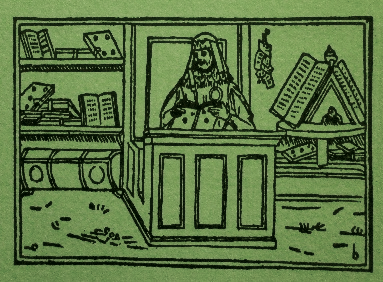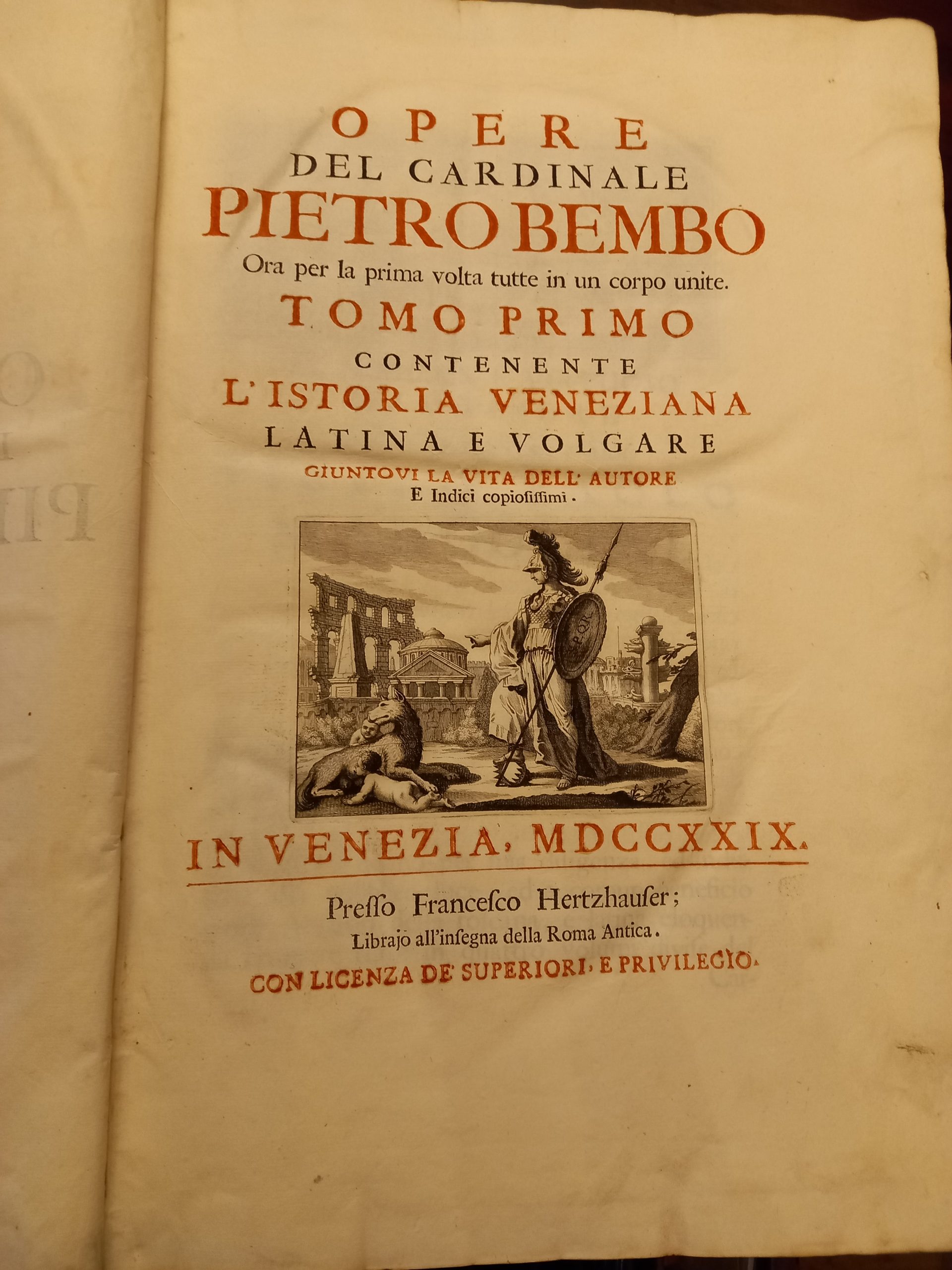In-folio (44 cm) 4 voll in due tomi (30) 337 (23) (1) c. (ritratto dell’autovre), (8) 237 (5) 241-299 (3) 64 (4) 220 (2); (8) 184 (6) 185-380 (6) 383-505 (1), (8) 359 (1). Numerose testatine con vignette calcografiche e capolettera incisi.Piena pergamena coeva con titolo manoscritto al dorso. Copia probabilmente appartenuta al sig. Gallicciolli, di cui è presente la firma di possesso.Lieve usure agli angoli dei piatti e qualche macchia alla pergamena. Ottimo esemplare. Tomo primo contenente l’Istoria veneziana latina e volgare giuntovi la vita dell’autore e indici copiosissimi: ritratto calcografico di Bembo disegnato e inciso da F. Zucchi. Fregio calcografico con stemma del dedicatario. 2: Tomo secondo contenente le Prose, gli Asolani, e le Rime, con varie scritture ed illustrazioni di altri autori, come nell’indice si dichiara. delle Prose erroneamente numerate 59, 60, 61 ed omesse le p. 62-63. Tomo terzo contenente le lettere volgari. Giuntovi indici copiosi e brevi annotazioni.4: Tomo quarto contenente i brevi scritti a nome di Lione 10., le Lettere famigliari, i tre Dialoghi, il trattato della imitazione e i Versi latini. Vi si e aggiunto l’indice degli autori, che del Bembo favellano, e la tavola copiosa delle materie. Pietro Bembo (Venezia, 20 maggio 1470 – Roma, 18 gennaio 1547) è stato un cardinale, scrittore, grammatico, poeta e umanista italiano.Appartenente a una nobile famiglia veneziana, fin dalla gioventù Pietro Bembo ebbe modo di costruirsi una solida formazione e reputazione letteraria grazie ai contatti con l’ambiente paterno e, in seguito, all’amicizia con Ludovico Ariosto, con Baldassarre Castiglione e alla consulenza per Aldo Manuzio. Il suo merito principale fu quello di contribuire in maniera significativa alla «codificazione dell’italiano scritto», uniformato al modello boccacciano, nell’opera che più di tutte lo ha reso famoso, «la grammatica più importante dell’intera storia dell’italiano», ossia le Prose nelle quali si ragiona della volgar lingua (1525). Parimenti decisivo fu il suo ruolo nella diffusione in tutta Europa del modello poetico petrarchista. Nominato cardinale nel 1539 da papa Paolo III, morì a Roma nel 1547. In-folio (44 cm) 4 vols in two volumes (30) 337 (23) (1) c. (author’s portrait), (8) 237 (5) 241-299 (3) 64 (4) 220 (2); (8) 184 (6) 185-380 (6) 383-505 (1), (8) 359 (1). Numerous headers with intaglio vignettes and engraved drop caps. Copy probably belonged to Mr. Gallicciolli, whose ownership signature is present.Full coeval parchment with handwritten title on the spine. Slight wear on the corners of the plates and some stains on the parchment. Excellent example. First volume containing the Latin and vulgar Venetian history, including the life of the author and very copious indexes: chalcographic portrait of Bembo drawn and engraved by F. Zucchi. Intaglio frieze with the dedicatee’s coat of arms. 2: Second volume containing the Prose, the Asolani, and the Rime, with various writings and illustrations by other authors, as stated in the index. of the Prose erroneously numbered 59, 60, 61 and the pages omitted. 62-63. Third volume containing the vulgar letters. Copious indexes and short notes have arrived.4: Fourth volume containing the short writings in the name of Lyon 10., the Family Letters, the three Dialogues, the treatise on imitation and the Latin verses. The index of the authors, who speak of Bembo, and the copious table of subjects have been added. Pietro Bembo (Venice, 20 May 1470 – Rome, 18 January 1547) was an Italian cardinal, writer, grammarian, poet and humanist. Belonging to a noble Venetian family, Pietro Bembo had the opportunity to build a solid education and reputation from his youth literary thanks to contacts with his father’s environment and, later, to his friendship with Ludovico Ariosto, with Baldassarre Castiglione and consultancy for Aldo Manuzio. His main merit was to contribute significantly to the “codification of written Italian”, aligned with the Boccaccia model, in the work that most of all made him famous, “the most important grammar in the entire history of Italian” , i.e. the Prose in which the vulgar language is discussed (1525). Equally decisive was his role in the diffusion of the Petrarchist poetic model throughout Europe. Appointed cardinal in 1539 by Pope Paul III, he died in Rome in 1547.
Libreria Emiliana
Antiquaria
Libri e Stampe Veneziane
dal XV al XXI Secolo
dal XV al XXI Secolo


